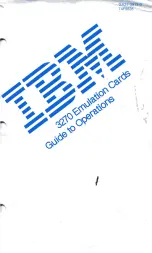
Co-Processor 15 (CP15)
88
SPRUH82C – April 2013 – Revised September 2016
Copyright © 2013–2016, Texas Instruments Incorporated
ARM Subsystem
2.7
Co-Processor 15 (CP15)
The system control coprocessor (CP15) is used to configure and control instruction and data caches,
Tightly-Coupled Memories (TCMs), Memory Management Units (MMUs), and many system functions. The
CP15 registers are only accessible with MRC and MCR instructions by the ARM in a privileged mode like
supervisor mode or system mode.
2.7.1 Addresses in an ARM926EJ-S System
Three different types of addresses exist in an ARM926EJ-S system. They are listed in
Table 2-2. Different Address Types in ARM System
Domain
ARM9EJ-S
Caches and MMU
TCM and AMBA Bus
Address type
Virtual Address (VA)
Modified Virtual Address (MVA)
Physical Address (PA)
An example of the address manipulation that occurs when the ARM9EJ-S core requests an instruction is
shown in
Example 2-1. Address Manipulation
The VA of the instruction is issued by the ARM9EJ-S core.
The VA is translated to the MVA. The Instruction Cache (Icache) and Memory Management Unit (MMU) detect
the MVA.
If the protection check carried out by the MMU on the MVA does not abort and the MVA tag is in the Icache,
the instruction data is returned to the ARM9EJ-S core.
If the protection check carried out by the MMU on the MVA does not abort, and the MVA tag is not in the
cache, then the MMU translates the MVA to produce the PA.
NOTE:
See the Programmers Model of the ARM926EJ-S Technical Reference Manual (TRM),
downloadable from
http://infocenter.arm.com/help/index.jsp
for more detailed information.
2.7.2 Memory Management Unit (MMU)
The ARM926EJ-S MMU provides virtual memory features required by operating systems such as
SymbianOS, WindowsCE, and Linux. A single set of two level page tables stored in main memory controls
the address translation, permission checks, and memory region attributes for both data and instruction
accesses. The MMU uses a single unified Translation Lookaside Buffer (TLB) to cache the information
held in the page tables.
The MMU features are as follows:
•
Standard ARM architecture v4 and v5 MMU mapping sizes, domains, and access protection scheme.
•
Mapping sizes are 1 MB (sections), 64 KB (large pages), 4 KB (small pages) and 1 KB (tiny pages)
•
Access permissions for large pages and small pages can be specified separately for each quarter of
the page (subpage permissions)
•
Hardware page table walks
•
Invalidate entire TLB, using CP15 register 8
•
Invalidate TLB entry, selected by MVA, using CP15 register 8
•
Lockdown of TLB entries, using CP15 register 10
NOTE:
See the Memory Management Unit of the ARM926EJ-S Technical Reference Manual (TRM),
downloadable from
http://infocenter.arm.com/help/index.jsp
for more detailed information.















































